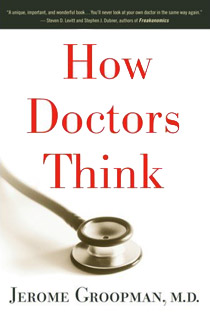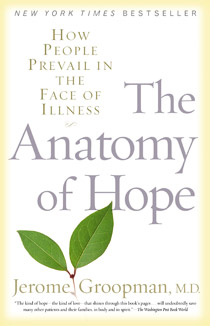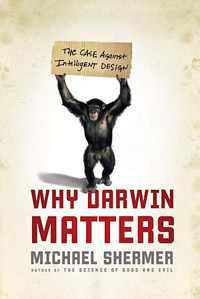In this week’s eSkeptic feature, Harriet Hall, M.D. reviews Jerome Groopman’s book How Doctors Think (Houghton Mifflin, 2007, ISBN 0618610030). Dr. Hall, the SkeptDoc, is Skeptic magazine’s resident expert on all matters medical.

How the Medical Mind Works
a book review by Harriet Hall, M.D.
Jerome Groopman’s book How Doctors Think is a superb commentary on the intersection between medical science, compassionate personal interactions, and critical thinking. My only caveat is that it may be exploited by “doctor-bashers” because it shows how doctors make mistakes; but the overall impact of the book is very positive. It is a good lesson in critical thinking about any subject, not just about medicine. It shows how people make up their minds and then resist changing them, twisting or disregarding subsequent evidence to make it fit their first hypothesis. It covers a number of other common mental foibles, illustrating them with memorable clinical vignettes. Groopman cites a recent study of 100 incorrect diagnoses: only four of them were due to inadequate medical knowledge; in the rest of the cases the doctors fell into cognitive traps. He targets errors that are particularly hazardous to doctors, such as poor communication with patients, buying into fad diagnoses, bowing to economic pressures, and succumbing to pharmaceutical company influences.
Doctors may be well educated, but they are no less subject to the various cognitive biases that plague the rest of humanity, educated or not. Thus, Groopman offers several guidelines to improve performance: don’t stop thinking after you reach a diagnosis; keep an open mind so you can reconsider if new data suggest another possibility; don’t skip steps in a misguided attempt to spare your patient discomfort; guard against treating patients differently because of your own emotions or prejudices; listen to the patient’s own story and make up your own mind rather than accepting the diagnosis of a previous doctor.
Groopman also gives practical advice to patients so they can help their doctors think better. They can offer to tell their story again from scratch to allow a fresh reassessment. They can ask, “What else could it be? Is there anything that doesn’t fit? Is it possible I have more than one problem?” If they have their own ideas about what might be wrong, or if they are worried about something the doctor hasn’t mentioned, they should speak up.
In the push towards evidence-based medicine, we encounter pitfalls. The evidence may have been derived from a group our patient doesn’t belong to. The Women’s Health Initiative showed that hormone replacement therapy did more harm than good, but it studied an older population: a later study on younger women showed that it did offer some benefits when used earlier in menopause. A treatment that is right for the “average” patient may not apply to the individual who falls on the end of the bell curve and has other co-existing health problems. This doesn’t mean we can disregard the evidence-based consensus. It means we should take the patient’s risk factors, concomitant illnesses, physiologic variants, current medications, allergies, life situation, personal preferences, etc. into account when choosing the best evidence-based option for that individual — not that we should exit the evidence-based playing field and try to invent a unique treatment for a unique patient using guesswork or intuition. Medicine is not an art, it’s an applied science; we need to make sure we’re applying it appropriately.
There is a place for clinical intuition. In an emergency, we don’t have the leisure to go through a lengthy process of weighing all the information — we have to make snap decisions to save lives. An experienced clinician may pick up on subtle clues he is not even conscious of. Of course, intuition can be misleading. Plus, medical science is messy. One clinical study is followed by another with a different conclusion. No test is 100% accurate. No treatment is guaranteed to work for every individual. Uncertainties abound.
The public believes x-rays and biopsies give clear yes-or-no answers, but that is not the case. They depend on human perception, pattern-recognition, and interpretation. Pathologists and radiologists often disagree with each other and even with themselves (in repeat readings). A radiologist who has recently missed a breast cancer is likely to over-read future mammograms in compensation. Computer-aided diagnosis may improve cancer detection but in one study it persuaded radiologists to change 10% of their correct readings to incorrect ones!
Groopman criticizes the current batch of medical students for relying too heavily on algorithms. “Clinical algorithms can be useful for run-of-the-mill diagnosis and treatment — distinguishing strep throat from viral pharyngitis, for example. But they quickly fall apart when a doctor needs to think outside their boxes, when symptoms are vague, or multiple and confusing, or when test results are inexact.” On the other hand, he shows how doctors can make mistakes by not following appropriate algorithms because they think their patient is unique and they can do better.
All too often there is no algorithm, no clear evidence-based guidance, and the doctor must make a difficult decision based on inadequate knowledge. Groopman illustrates the soul-searching, self-doubting worries that all good clinicians struggle with. How can we know we did the “right” thing if there is no “right” thing?
Groopman says, “Statistics embody averages, not individuals.” The average benefit of mammography may be less than the benefit to a woman with previous breast biopsies, a family history of breast cancer, and several other risk factors. In cancer, the evidence may show that chemotherapy improves survival on average; but it’s a gamble because it doesn’t help everyone and may shorten survival for a few. There are other considerations such as side effects, quality of life, and limitations on lifestyle. Given the same information, one patient may choose chemotherapy while another chooses no treatment, and a good doctor tries to understand and support either choice.
I was so impressed by How Doctors Think that I went on to read Groopman’s previous book, The Anatomy of Hope. I was even more impressed by that one. He describes his experiences as an oncologist, showing how false hope can be damaging but how there can always be real hope based on coping with reality. He tells the stories of patients who refused chemotherapy and about one who demanded even more chemo than his doctors recommended; and he helps the reader understand the thought processes involved. One woman refused treatment because she thought the cancer was her punishment for sins she had committed, one man had watched a friend die of another cancer and mistakenly thought his own (curable) cancer was the same thing. He shows how patients can live worthwhile lives “with” cancer, even when it can’t be cured. If there isn’t hope of cure, there is always hope of a better life while life lasts. I wish everyone who treats cancer, has cancer, or knows someone who has cancer could read this book.
One of the stories in The Anatomy of Hope is Groopman’s own story. He had a ruptured disc, failed surgery, and chronic back pain that limited his activities severely for 19 years. Finally he ran into a rehabilitation specialist who convinced him that the pain didn’t mean what he thought it meant. He had been avoiding any pain-inducing activities on the assumption that it was telling him his body would be harmed by those activities. He re-conceptualized the pain as meaning that he was so de-conditioned that his body had been trained to irrationally protest at normal, safe activities. With an intensive training program, he was able to build up his muscle strength and mobility again and he now leads a normal life and is pain-free.
This is a great example of how the mind influences recovery. Not woo-woo thought transfer or mind-over-matter, but proper reality-based thinking about symptoms that can facilitate appropriate treatment.
Groopman is a wise old soul. If every evidence-based medical doctor applied real science with his kind of judgment and compassion, alternative medicine might curl up and die.
Shermer on CNN’s Glenn Beck show
on 9/11 Conspiracy Theories

Last Friday night Bill Maher’s HBO series was disrupted by a gaggle of obnoxiously loud 9/11 conspiracy theory “truthers” (as they like to call themselves), resulting in Bill charging up the aisle himself to throw them out of the studio. Last night I appeared on CNN’s Glenn Beck show to discuss and debunk. WATCH the video >
Debate: Michael Shermer v. Dinesh D’Souza
Oregon State University, October 15, 2007
After watching my debate with Dinesh D’Souza last week I would be interested in your comments and constructive criticisms because Dinesh and I will be debating a similar but broader topic in December at Caltech (“Is Religion a Force for Good or Evil? & Can you be Good without God?” December 9, Beckman Auditorium, tickets available at the Caltech Public Events Office at 626-395-4652 or toll free at 888-222-5832).
Please email your comments to me at mshermer@skeptic.com.
Below are a few of my notes used during the debate. Most of the studies I reference about how atheists are just as moral as theists come from my book The Science of Good and Evil. The more recent studies are reported in either Skeptic magazine or in my Skeptic column in Scientific American. I had 25 minutes to cover five points.
Is Christianity Good for the World?
notes from Michael Shermer
1. What Are We Debating?
“Is Christianity Good for the World?” The answer is obvious: It Depends!
Religion is so complex, so all-encompassing, so sweeping and culturally enveloping that it would be absurdly simplistic to offer a simple “yes” or “no” answer, comparable to asking “Is government good for the world?”
Religion is good when it does good, and bad when it does bad.
Christianity reminds me of Winston Churchill’s comment about Americans: “You can always count on Americans to do the right thing… after they’ve tried everything else.” Well, you can always count on Christians to do the right thing…after they have tried everything else.”
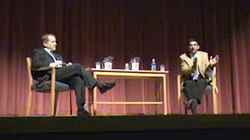
Michael Shermer & Dinesh D’Souza
WATCH the debate video
2. Which Christianity? Good for Whom?
Which Christianity? (Catholic, Protestant, Evangelical, Mormon, Episcopalian, Pentecostal?) 33,800 different Christian denominations worldwide. Which is the right one? Good for whom? Individuals, communities, society?
- Protestant Christians determined to murder Catholic Christians over turf in Northern Ireland? Not good.
- Mormon Christians who belong to the fundamentalist Church of Jesus Christ of Latter Day Saints who believe that is acceptable to force 13-year old girls to have sex with men five times their age? Not Good.
- Pentecostal Christians who indoctrinate young children at Jesus camps into becoming warriors for Christ who are willing to kill for their lord? Not good.
- Evangelical Christians who believe so strongly in the sanctity of life that they blow up abortion clinics and kill doctors? Not good.
- Catholic Christians whose Priestly pedophile program of, in the words of Christopher Hitchens, “No Child’s Behind Left”? Not good.
3. Gay Marriage & Homosexuality as a Case Study
The issue of Gay marriage in particular and homosexuality in general is a case study in what is wrong with religion, especially Christianity.
The overwhelming evidence from science shows that gender preference is primarily determined by our genetics and prenatal biochemistry, especially embryological hormone balance. Almost everyone is born attracted to members of the opposite sex. A tiny percentage — perhaps as few as one to two percent — are attracted to members of the same sex.
Asking a homosexual when he or she chose to become gay is like asking a heterosexual when he or she chose to become straight.
Nevertheless, on this particular issue Christianity remains mired in pre-civil rights, pre-enlightenment, even pre-scientific thinking, basing their beliefs on a single biblical passage (Leviticus 18:22: “Thou shalt not lie with mankind, as with womankind: it is abomination”) that itself is tucked in between other passages that instruct parents to kill their disobedient children and to execute adulterous wives and nonvirgin brides. That’s right, the death penalty for adultery, which would immediately eliminate a good number of Christian Congressmen and Senators, preachers and televangelists.
As a consequence of this embarrassing lapse of Christian charity, Christian preachers, writers, and theologians think nothing of tormenting gays by telling them that their desire to love another person of the same sex is an “abomination,” by telling them that they have a disease that can be “cured” through “treatment” (such as forcing gay guys to watch football games), and by telling them that promiscuity is evil but that the single best prophylactic against it — marriage — is legally banned from them.
Christians actually believe they are being charitable by proclaiming that they “hate the sin, not the sinner,” which is not dissimilar to what Christians declared just before torching women for allegedly practicing witchcraft in order to save their souls, or when Christians called for pogroms against Jews for being Christ-killers. (May I point out that if Jesus had to die for our sins, that means someone had to kill him, and therefore that someone should be thanked, not persecuted and murdered.)
Mark my words. Here is what is going to happen. Within a decade, maybe two or three, Christians will come around to treating gays no differently than they now treat other groups whom they previously persecuted — women, Jews, blacks — but not because of some new interpretation of a biblical passage, or because of a new revelation from God. These changes will come about the same way that they always do: by the oppressed minority fighting for the right to be treated equally, and by a few enlightened members of the oppressing majority supporting their cause.
Then what will happen is that Christians will take credit for the civil liberation of gays, dig through the historical record and fine a few Christian bloggers or preachers who had the courage and the character to stand up for Gay rights when their fellow Christians would not, and then cite those as evidence that were it not for Christianity gays would not be equal.
4. Religion and Societal Morality
In a 2005 study published in the Journal of Religion and Society, independent scholar Gregory S. Paul found an inverse correlation between religiosity (measured by belief in God, biblical literalism, and frequency of prayer and service attendance) and societal health (measured by rates of homicide, suicide, childhood mortality, life expectancy, sexually transmitted diseases, abortion, and teen pregnancy) in 18 developed democracies. “In general, higher rates of belief in and worship of a creator correlate with higher rates of homicide, juvenile and early adult mortality, STD infection rates, teen pregnancy, and abortion in the prosperous democracies,” Paul found. “The United States is almost always the most dysfunctional of the developed democracies, sometimes spectacularly so.” Indeed, the U.S. scores the highest in religiosity and the highest (by far) in homicides, STDs, abortions, and teen pregnancies. Conservative Christians, of course, will blame secular liberals for all these societal ills, but with over 90 percent of Americans proclaiming themselves to be Christians, and the country roughly split 50/50 between conservatives and liberals, this does not add up.
5. Religion and Individual Morality
In 1934, Abraham Franzblau found a negative correlation between acceptance of religious beliefs and three different measures of honesty. As religiosity increased, honesty decreased.
In 1950, Murray Ross conducted a survey among 2,000 associates of the YMCA and discovered that agnostics and atheists were more likely to express their willingness to aid the poor than those who rated themselves as deeply religious.
In 1969, sociologists Travis Hirschi and Rodney Stark reported no difference in the self-reported likelihood to commit crimes between children who attended church regularly and those who did not.
In 1975, Ronald Smith, Gregory Wheeler, and Edward Diener discovered that college-aged students in religious schools were no less likely to cheat on a test than their atheist and agnostic counterparts in nonreligious schools.
In 1996 George Barna, a born-again Evangelical Christian, in his Index of Leading Spiritual Indicators, based on interviews with nearly 4,000 adult Americans, revealed: “Born again Christians continue to have a higher likelihood of getting divorced than do non-Christians.” And: “Atheists are less likely to get divorced than are born-again Christians.” Barna found that the current divorce rate for born-again Christians is 27 percent, while it is only 24 percent for non-Christians. In addition, the Baby Boomers — that generation often criticized for sexual indulgence and moral relativism — has a lower rate of divorce (34 percent) than the preceding generation (portrayed in popular culture as the idealized 1950’s Ozzie and Harriet family), who hover at 37 percent.
Five years later, in a 2001 survey, Barna found that “33 percent of all born again individuals who have been married have gone through a divorce, which is statistically identical to the 34 percent incidence among non-born again adults.”
The July/August 2007 issue of the Annals of Family Medicine published the results of a study conducted by researchers from the University of Chicago and Yale New Haven Hospital that religious doctors were no more likely (and even slightly less likely) to employ their craft among underserved patients than were physicians with no religious affiliation. Specifically, Farr Curlin, MD, an assistant professor of medicine at the University of Chicago and his colleagues surveyed 1,820 practicing physicians from all specialties: 31% of physicians who were more religious practiced medicine among the underserved, compared to 35% of atheist, agnostic, and nonreligious doctors. Religiosity was measured by religious service attendance and self-reported “intrinsic religiosity” questions that measured the extent to which individuals embrace their religion as the “master motive that guides and gives meaning to their life.” Curlin noted his own response to the data: “This came as both a surprise and a disappointment. The Christian, Jewish, Muslim, Hindu and Buddhist scriptures all urge physicians to care for the poor, and the great majority of religious physicians describe their practice of medicine as a calling. Yet we found that religious physicians were not more likely to report practice among the underserved than their secular colleagues.”
The key to understanding who helps the needy the most was spirituality, not religiosity. According to Curlin, those who identified themselves as very spiritual, whether or not they were religious, were roughly twice as likely to care for the underserved as those who described their spirituality as low. “Part of this divergence between religion and spirituality can be traced to a rift between Christian denominations in the late-19th and early-20th centuries,” Curlin concluded. About a century ago, he noted, many of the mainline and liberal Protestant churches began “to emphasize efforts to right social injustices, while the more conservative churches tended to stress doctrinal orthodoxy. Research indicates that those who consider themselves spiritual but not so religious are more likely to be formed in the more liberal denominations.” Curlin added that he is an orthodox Christian in the Protestant tradition.
Conclusion
Absolute morality leads logically to absolute intolerance. Once you believe that you have the absolute and final answers to moral questions, why be tolerant of those who refuse to accept your Truth? Religiously based moral systems apply this principle in spades. From the medieval Crusades and the Spanish Inquisition to the Holocaust and Bosnia, history is rife with examples of intolerance. In the name of their religion, people have lighted faggots to burn women accused of witchcraft. In the name of God, religious people have sanctioned slavery, anti-Semitism, racism, homophobia, torture, genocide, ethnic cleansing, and war. Not only does religion not necessarily make one more moral, it can lead to greater intolerance, racism, sexism, and the erosion of other values cherished in a free and democratic society.
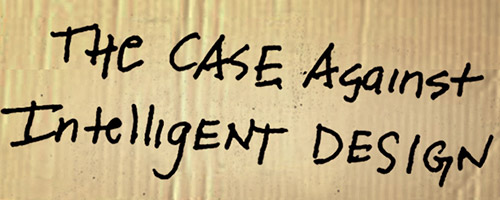
Why Darwin Matters (detail of cover)
Why Darwin Matters in paperback
now available at Shop Skeptic
Evolution happened, and the theory describing it is one of the most well founded in all of science. Then why do half of all Americans reject it? In Why Darwin Matters, historian of science and bestselling author Michael Shermer defuses these fears by examining what evolution really is, how we know it happened, and how to test it. Shermer then discusses what science is through a brief history of the evolution-creation controversy from the Scopes “Monkey” trial of 1925, through the U.S. Supreme Court case of 1987, to the ongoing trials today, demonstrating clearly how and why creationism and Intelligent Design theory are not science. READ more…


